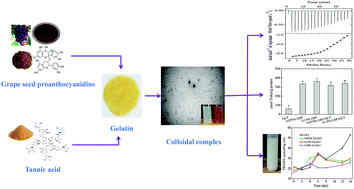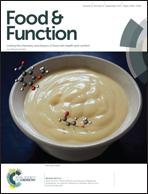Self-assembled colloidal complexes of polyphenol–gelatin and their stabilizing effects on emulsions
Abstract
This research studies the in-depth characteristics including the binding interactions and morphological structure of tannic acid (TA)/grape seed proanthocyanidins (GSP) and gelatin (GLT) colloidal complexes, and evaluated the stability and lipid oxidation of emulsions formed by the colloidal complexes. Polyphenol and GLT (1.2 wt%) self-assembled complexes were fabricated by varying the mass ratio (1 : 16, 1 : 8 and 1 : 4) and pH in the range of 3–7. TA and GSP can form stable colloidal complexes with GLT at the nanoscale at pH 6, as shown by the particle size results, and the complexes exhibited a spherical morphology as seen by transmission electron microscopy. Hydrogen bonding was the main binding force for the interaction between polyphenols and GLT. The antioxidant activity of GLT was greatly improved after complexing with polyphenols. The oil/water emulsion formed by the complexes had a smaller droplet size and higher lipid oxidation stability during storage. This was largely due to the physical barrier formed by polyphenol–GLT colloidal complexes at the oil–water interface, which can prevent the pro-oxidant from penetrating into oil. These results clarified the structural, morphological and antioxidant properties of polyphenol–gelatin non-covalent complexes, which is of great value for their application in food solutions as well as in emulsion systems.



 Please wait while we load your content...
Please wait while we load your content...